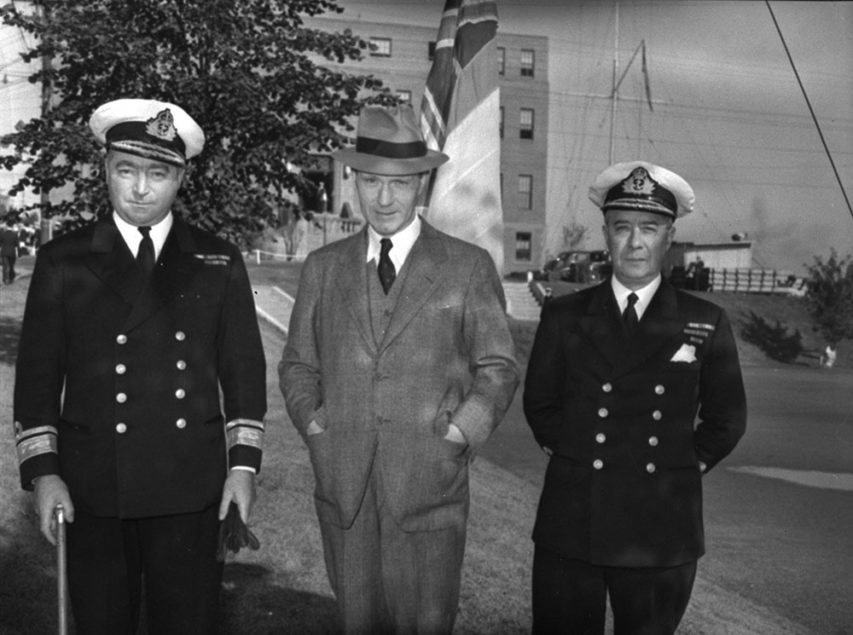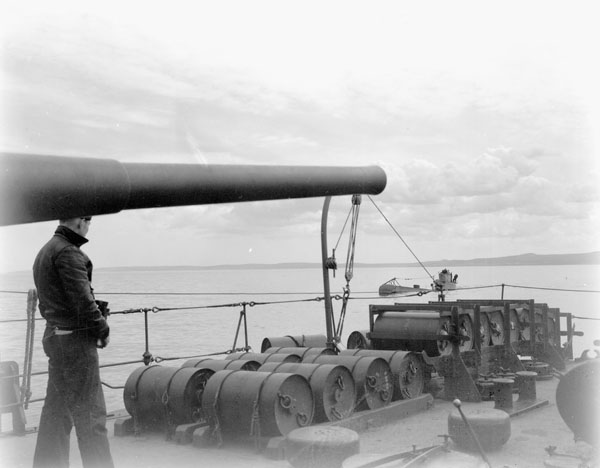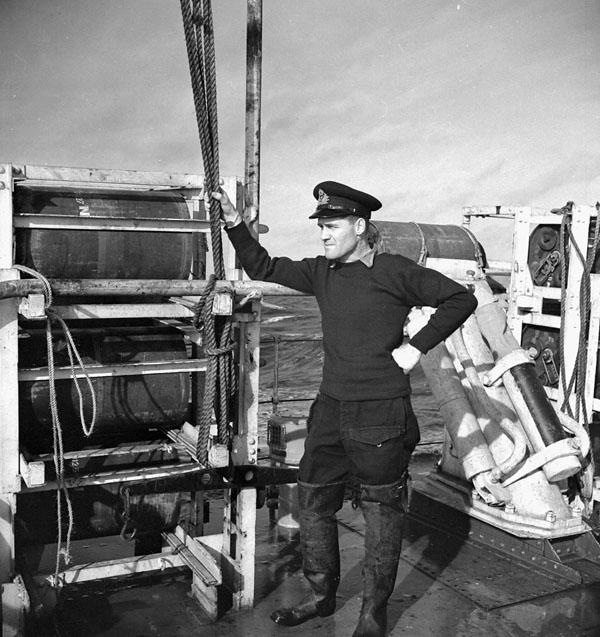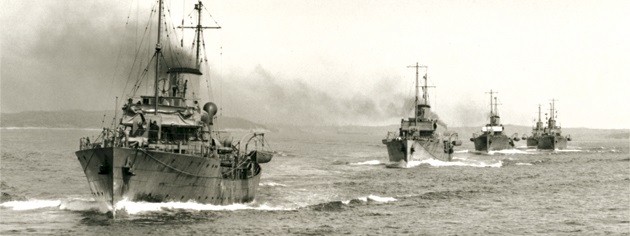Overly Sarcastic Productions
Published on 5 Apr 2019Everybody loves a good creation myth. The Aztecs loved it so much they did it five whole times! I’d call it “overkill”, but compared to all the other stuff the aztecs believed, four mythical extinction events is actually remarkably tame.
April 9, 2019
Miscellaneous Myths: The Five Suns
Canada and the Battle of the Atlantic, part 8 by Alex Funk
Editor’s Note: This series was originally published by Alex Funk on the TimeGhostArmy forums (original URL – https://community.timeghost.tv/t/canada-and-the-battle-of-the-atlantic-part-3/1442).
Sources:
- Far Distant Ships, Joseph Schull, ISBN 10 0773721606 (An official operational account published in 1950, somewhat sensationalist)
[Schull’s book was published in part because the funding for the official history team had been cut and they did not feel that the RCN’s contribution to the Battle of the Atlantic should have no official recognition. It is very much an artifact of its era, and needs to be read that way. A more balanced (and weighty) history didn’t appear until the publication of No Higher Purpose and A Blue Water Navy in 2002, parts 1 and 2 of the Official Operational History of the RCN in WW2, covering 1939-1943 and 1943-1945, respectively.]- North Atlantic Run: the Royal Canadian Navy and the battle for the convoys, Marc Milner, ISBN 10 0802025447 (Written in an attempt to give a more strategic view of Canada’s contribution than Schull’s work, published 1985)
- Reader’s Digest: The Canadians At War: Volumes 1 & 2 ISBN 10 0888501617 (A compilation of articles ranging from personal stories to overviews of Canadian involvement in a particular campaign. Contains excerpts from a number of more obscure Canadian books written after the war, published 1969)
- All photos used exist in the Public Domain and are from the National Archives of Canada, unless otherwise noted in the caption.
I have inserted occasional comments in [square brackets] and links to other sources that do not appear in the original posts. A few minor edits have also been made for clarity.
Earlier parts of this series:
Part 8 — Expansion problems: not enough men for not enough ships
Marc Milner discusses the RCN’s ongoing manning crisis afloat and ashore in North Atlantic Run:
… it was also necessary to find personnel to man new shore establishments. Indeed, by early 1941 the latter took precedence of the needs of the fleet. Although the navy remained committed to increasing the number of escort numbers assigned to its first operational priority, defence of the North Atlantic trade lanes, the gradual extension of the war underlined the paramount need for bases. “Our primary object from the Naval point of view,” a Canadian Chiefs of Staff “appreciation” of May 1941 observed, “must therefore be the extension of existing facilities and the provision of new ones to meet the ever-increasing demands of the British — and perhaps the United States — Naval forces.” The expansion fleet was then only one part of a much larger plan of support for North Atlantic naval operations. Moreover, actual planning for the commissioning and work-up of the new escorts took place as the fleet assumed new and more demanding tasks.
The concern of the Chiefs of Staff for facilities underlined the fact that even by the second winter of the war the navy’s growth was still held in check by enormous shortages. … The Director of Naval Personnel, Captain H.T.W. Grant, informed the council that the RCN needed three hundred RCNVR executive officers — none of whom had yet been enlisted — if the authorized commitments for the following May were to be met. This was no mean task in itself, but the Naval Council noted that the training establishments needed to prepare the men had to be built first. The final twist occurred when the minister advised that the navy must first make steps to acquire the necessary land!
As Nelles later explained in a personal letter to Admiral Sir Dudley Pound, the First Sea Lord, the RCN was indeed making bricks without straw. … The primary need was now quantity in all aspects of naval endeavour — manpower, ships, and bases.
With existing training establishments choked and new ones still in the planning stages, the provision of personnel for the expanding fleet posed a serious problem. Urgency was to Canadian planning in late 1940, when it became clear that Britain was involved in what Nelles described as “a Naval crisis equal [to] or greater than that which existed in 1917.”

Hon. Angus L. Macdonald, Minister of National Defence for Naval Services, with senior RCN officers, Commodore H.E. Reid and Rear-Admiral P.W. Nelles, September 1940.
Canada. Dept. of National Defence / Library and Archives Canada / PA-104112
To help address the RCNVR officer shortage, a deal was agreed between the RCN and the RN by which RCNVR officers-in-training would travel to England and receive training at HMS King Alfred, the reservist training centre at Hove:
The great irony of the scheme was that it proved virtually impossible to draw on this body of highly trained Canadian naval officers later on, when the RCN was badly in need of qualified personnel. Certainly the King Alfred plan did nothing to resolve the shortage of qualified officers that crippled the fleet in 1941.
Another aspect of proper planning was work-up and operational training facilities for the fleet, particularly with respect to ASW.
Especially considering numerous British complaints of the low quality of Canadian ASW efforts on destroyers operating from UK bases. Canada had possessed no submarines since 1922 and had long since lost the ability to operate them. There was one submarine operating with the RN’s Third Battle Squadron out of Halifax: the Dutch O-15:
At the end of November, the Naval Staff formally requested that O-15 be made available for A/S training. For the moment, the Admiralty refused, although some exercises were conducted with her later in the year.
[Editor’s Note: The Dutch Submarines page on O-15 says “… the RCN was so desperate for ASW training in 1940 that when a Dutch submarine, which had avoided capture when Holland was invaded, fetched up in Halifax en route to England, the navy used it without permission and would not let it go when the Admiralty asked them to relinquish her …”]
Unable to obtain satisfaction from British sources, the RCN turned to the US, where preliminary investigations into acquiring an older USN submarine were made in early 1941. Commodore H.E. Reid, the naval attaché in Washington, raised the matter with the new Permanent Joint US-Canadian Board of Defense and then set about beating the bushes in more obscure parts of the American capital. By the end of January it was clear there were no submarines of any description would be forthcoming from American sources. The only gesture of assistance that the USN made was an offer to send a squadron of submarines (four boats) on a courtesy visit sometime in the summer. The RCN was advised to prepare itself to make maximum use of two to three weeks of free ASDIC training time. It was a generous offer, but it did not provide the RCN with a long-term solution to the pressing problem of providing ASDIC trainees with proper targets. Probably for this reason and because of the fear that acceptance would prejudice negotiations still underway regarding the future of O-15, the RCN politely declined the American offer. A few days later the Admiralty signalled its consent to the use of O-15 for A/S training.

View from HMCS ST Laurent of the submarine O-15 of the Royal Netherlands Navy during an anti-submarine training exercise off Pictou, Nova Scotia, Canada, 20 August 1941.
Canada. Dept. of National Defence / Library and Archives Canada / PA-105491
While extremely useful, one submarine was not sufficient for all training needs and the shortage would continue until 1943 when Italian and Free French submarines became available in the Western Atlantic to help train US-built British destroyer escorts commissioning from US ports.
… having secured the services of O-15, there was no reason not to return to the American offer of training time on US submarines. That the RCN saw fit to reject direct USN assistance was the first sign of what became a curious, closely guarded attitude on the part of the RCN towards the USN. Nor were training submarines the only answer to preparing escorts for battle with the U-boats. Had the RCN — and the RN, for that matter — been more attuned to developments in the war at sea and seen the U-boat pack for what it really was, a flotilla of submersible torpedo boats, motor launches would have formed an essential part of A/S training as well. These small craft offered an excellent substitute for a training submarine in exercises designed to simulate night attacks on convoys, but it was not until 1942 that the RCN would begin to use launches for that purpose. The continuing fixation with submerged targets was understandable, since training on an actual submarine was the only means of attaining and maintaining efficiency among ASDIC operators. …
Aside from the escorts operating from the UK, RCN expansion hung fire during the winter of 1940-1. Obviously it would have been better to commission twenty corvettes into the RCN during 1940, as the Staff had originally planned. But when winter closed its icy grip on the St. Lawrence River, only four were operational.
A few more ships were patrolling and training in Pacific waters, and they would be joined by fresh ships commissioned on the west coast from British Columbian yards over the winter (six ships all told). The last week of April brought the thaw, and with spring came the expected deluge of new ships. Orillia, Pictou, and Rimouski were down the river before the month ended. In May, ten more were accepted into service, three for the west, six for the east. (Including HMCS Baddeck, the ship that Captain Alan Easton, whose firsthand account I find quite fascinating, first commanded.)
In a period of seven months thirty-three warships were added to the Navy List, slightly over half of the 1939-40 construction program.
Had it been possible to build the fleet entirely on the Atlantic or Pacific coasts, the seasonal character of expansion would have been averted. But because of the heavy demand for repair work on east coast yards after the fall of France only three orders for corvettes were ever placed east of the St. Lawrence River. [All at Saint John Shipbuilding.] All of these were much delayed, and the last to commission, Moncton not taken into service until April 1942 — two full years after the commencement of the program.
Lieutenant-Commander Easton described his first look at and first voyage of the Baddeck in 50 North: Canada’s Atlantic Battleground:
She was resting on the blocks of a dry-dock in a shipyard farther up the [St. Lawrence] river when I first saw her. I had stood on the wall and looked down at her sturdy features, the brand new vessel which was to take me many miles over the ocean. HMCS Baddeck was mine; we were to share at least a part of our lives together.
I was elated at being given command. I could not thank anybody because the news came in a naval signal, one of those pieces of paper rather like a telegram, but without the advertising at the top. I just had time to catch the night train from Halifax to Quebec.
When anyone is given an appointment which places him in charge of something which he thinks is pretty important, it generally makes him feel he has been singled out as being above the crowd. But this was not so in my case; the authorities who selected me probably had no alternative. There was no one else handy. In the Royal Canadian Navy during the first half of the war, there were not enough people to go round. Often you got the job whether you deserved it or not.
I could see now that the ship had been built mainly after the fashion of a big steam trawler, but with a longer and sharper bow. From drawings I had seen I knew she was 204 feet long and had a thirty-three-foot beam. Her appearance fitted these dimentions and in her nakedness her fat belly seemed to bulge over the floor of the dry dock, suggesting an ample capacity for, among other things, a large engine. Her rounded stern was inclined to turn up like a duck’s tail.
[…]
The first sight of a ship in which one is going to sail is always exciting, that first intensely interesting glimpse which creates an immediate impression — sometimes of disappointment. […] This time I was not disappointed. And as I stood on her deck, I felt alone with her in the silence of the deserted yard. It was Sunday and everything was quiet — no hammering or riveting, no trail of steam drifting up from the machine shop. Would she stay young like this or grow old quickly? I was glad it was quiet because this was my private introduction and she would try to show me herself — before our exploits began.
Exploits? That was the trouble. She might never be involved in a fight. A corvette, after all, was designed for coastal patrol work. And Canada had a long coastline. The war was on the other side of the Atlantic.
It was a month or more before I had an opportunity to try out her promises of performance on the broad reaches of the St. Lawrence below Quebec. She had been fitted out, her crew had come on board and she had been duly commissioned into the Royal Canadian Navy.
Many men felt strange. But this alien environment was what a good many expected, even sought, when they joined the navy. Stokers looked into the furnaces and felt the burners they would be tending. They looked for a quiet spot in the mess deck to sling their hammocks. They did not know then there would be no quiet spot. Most of them — for most were new to this — felt a twinge of concern and a little ache of homesickness. But these were hidden by an extra swing of the shoulder and more noise than necessary.
There had been no fanfare on leaving. No “off to war” business. Just a farewell hoot of the whistle as we pulled out into the river and headed down-stream for the coast. […] Of the three officers, only the navigator had been in a ship before. He had been twenty-five years at sea in all sorts of small vessels. He had started to sea in fishing vessels when he was twelve, and had gone on from schooners to small steamers to become master of a coastal tanker. He was a rough and readly little man and a rule-of-thumb navigator, I suspected; not that I was disinclined to be one myself. Of the 50 men, about five had been professional sailors or fishermen and, below, no more than six were experienced with engines and boilers. So with more than three-quarters of the complement as fresh to the sea as the ship herself, it was hard to perform our simple task; hard to keep steam up, avoid the shoals or even to steer a straight course. Had anything warlike occurred there would have been a shambles.
Thus, while we were on patrol, the few who knew their profession taught the others. The principles had been explained to them ashore and our specialists had been well instructed, but when they came to supply their knowledge in the ship, a place where discomfort alone had a dazing effect on the mind as well as the stomach, it did not always work out as expected.
We went at it systematically. I had been back at sea almost continuously since the beginning of the war. I was, therefore, in a fair position to know what was needed to develop the crew.
Boats were lowered many times and rowed and then hoisted; men swung the lead for soundings; they put out fires; they were taught lookout-keeping; they learned to read a swinging compass and compensate with the wheel; to stoke the furnaces without belching smoke; handle guns in a choppy sea and to throw a heaving line. But all of this was not learned easily.
Coming in from one of the patrols we were going alongside a jetty, which was overlooked by the admiral’s office; the admiral was known to be fond of observing his ships docking. A strong offshore wind was blowing. It was now or never with the heaving line as the bow of the ship drew parallel to the jetty at a nice throwing distance. An able seaman heaved but his line went up like the first act of the Indian rope trick instead of across the gap. It came down in the water on the lee side. The gap widened but another man standing by with a spare coiled line, in case the first man missed, heaved. It reached the jetty and was caught but the thrower was empty-handed. The end of the rope had gone too! The ship drifted away. And the admiral looked down from his window on the performance.

Lieutenant-Commander Alan H. Easton, DSC, Commanding Officer of the frigate HMCS Matane, Halifax, Nova Scotia, Canada, January 1944.
Lt. Gilbert A. Milne / Canada. Dept. of National Defence / Library and Archives Canada / PA-206442
Marc Milner, North Atlantic Run:
Staff preoccupation with a myriad of apparently non-essential matters also stemmed from the lack of any sense of urgency over the commissioning of the corvette fleet, at least for operational purposes. Despite Nelles’ stated concern over a possible repeat of 1917, even the Admiralty advised in February 1941 that the RCN could accept a delay in the attainment of competence by its own corvettes. Further, although the navy ardently desired to play a full role overseas in what Nelles described as the “theatre of active operations”, the Naval Staff decided in October 1940 that the products of the first construction program would go to meet home requirement first. Once fifty per cent of the latter were met, escorts would be sent to the Eastern Atlantic — the war zone — on an equal priority basis.
Despite the policy of sending auxiliaries overseas and the sure knowledge that the RN was already using its own corvettes as ocean escorts, there is no indication that the RCN believed either that its corvettes would be called up for similar activities or that they required modification to make them more suited to an ocean escort role. In fact, Canadian escorts were primarily intended for inshore duty, as had been the original intentions of the British as well. But the inshore role of Canada’s corvettes was reinforced by defense arrangements made between the US and Canada after the fall of Western Europe. In August 1940 the new Canadian-American Permanent Joint Board of Defence produce its first basic defence plan (Number 1) for North America. It adopted a worst-case scenario, the defeat of Britain by Germany, followed by a contined state of war between Germany and the Commonwealth, from which it took its sobriquet, Plan “Black”.
Canadian corvettes under Plan Black were to be formed into five-ship ASW strike forces that would hunt down and destroy U-boats for the RCN’s system of defended ports. Primarily hunting in the approaches to harbours or at the focal points of trade. “It was expected that in some cases, notably off Halifax and Sydney, corvettes would conduct some local escort, though for Canadian purposes this was not their primary role.”
In addition to this offensive use of corvettes, the navy also looked forward to the commissioning of the first construction-program ships in order to proceed with many aspects of expansion, such as training. For the professional navy at least the corvette fleet was not the embodiment of naval expansion. Rather it was, as Nelles described it, a “stepping stone”. Events at sea would soon change this, but it would take some time before that change affected attitudes in Ottawa.
On the ocean, as the war at sea intensified it pushed further westward. Over the winter the dispersal points under British ASW escort had moved steadily into the mid-Atlantic. The bases in established in Iceland in April 1941 allowed escort to roughly 35 degrees west.
This move, in conjunction with a similar extension of air escort, proved initially successful. During April three convoys were attacked in the area that had previously uncovered by A/S escorts, and three U-boats were sunk in the ensuing actions. The Germans, once again finding the climate around defended trade too unhealthy, simply pushed farther west. In May they struck at Halifax-to-UK convoy HX-126 as it approached the limits of A/S cover. Before the escort could join, a U-boat pack of six attackers sank five ships. In the face of a continued threat, the convoy was dispersed, which led to further losses. To forestall further German success, the gap in continuous A/S escort of convoys between the limits of local Canadian escorts and those of the RN based in Iceland needed to be filled.
Siege of Vienna – Opening Bombardment – Extra History – #1
Extra Credits
Published on 6 Apr 2019Mehmed IV wanted to live up to, and even surpass, the legacy of his forefather Mehmed II, who had secured the Ottomans’ inheritance to the Roman Empire through his conquest of Constantinople. So the current Mehmed decided to target Vienna — but Emperor Leopold dismissed these threats…
Over a hundred thousand Ottoman troops are heading for Vienna. Only 15,000 men defend the walls. They have only six days to prepare the city. How long can they hold?
Join us on Patreon! http://bit.ly/EHPatreon
Blue’s Dumb History Tales
Overly Sarcastic Productions
Published on 8 Mar 2019Please check out That Works for the best blacksmithing on YouTube: https://goo.gl/vXsuFt
What do you get when you cross a month that has 5 Fridays with a historian who can’t do math? This nonsense, apparently.
PATREON: https://www.patreon.com/OSP
QotD: It won’t be easy to bring back politicians’ willingness to compromise
I think the donors are a problem for both parties, in terms of driving choices that aren’t necessarily the best strategies for building the base. (Both parties completely missed the populist backlash on trade, for example. Now, as a free trader, I like the resulting policy. But they paid for it at the polls.) But the issue isn’t fundamentally the donors. The issue is that fundamentally, both sides hate each other, and both sides have an increasing “It is not enough that I win. My enemies must lose” mentality about politics. Combine that with various reforms that have empowered extremists — campaign finance reforms that empowered outside groups, yes, but also the shift to primaries from conventions, and the abolition of the earmarks and pork that used to grease legislative passage. Throw in the “Great Sort” into increasingly politically homogenous communities — those are the problems you need to fix if you want to bring back legislative compromise. And damned if I know how we get there, because you can’t tell people where to live, and anyone who suggested getting rid of primary elections and bringing back pork barrel politics would come off as a backroom sleaze.
Megan McArdle, “Ask Me Anything”, Reddit, 2017-04-10.




